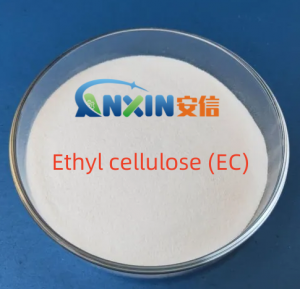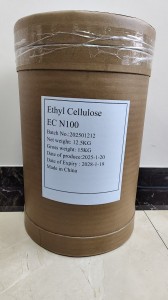Ethyl cellulose (EC) is a nonionic cellulose ether derived from natural cellulose through ethylation. Its unique physical and chemical properties make it widely applicable in coatings, pharmaceuticals, food, and industrial applications.
1. Basic Properties
1.1. Molecular Structure and Solubility
Ethyl cellulose is obtained by partially ethylating the hydroxyl groups of a cellulose molecule. Its hydrophobicity and solubility vary depending on the degree of ethoxyl substitution (DE). EC is insoluble in water but soluble in a variety of organic solvents, such as alcohols, ketones, and aromatic hydrocarbons. Therefore, it is often used for film formation and thickening in organic solvent systems.
1.2. Thermal Stability
EC exhibits excellent thermal stability, typically maintaining a stable structure at temperatures between 150°C and 200°C and resisting decomposition. This gives it advantages in high-temperature processing and thermosetting systems.
1.3. Mechanical and Physical Properties
EC films exhibit excellent toughness and flexibility. The films are transparent and smooth after formation, and can effectively improve the surface smoothness of materials. Furthermore, EC powders have excellent flowability, making them easy to process and prepare uniform solutions.
2. Functional Properties
2.1. Thickening and Suspension
EC dissolved in organic solvents forms a viscous liquid, increasing the viscosity of the system and thus improving rheological properties. In coatings, inks, and paints, EC can act as a thickener and suspending agent, preventing the settling of pigments and fillers and improving system stability.
2.2. Film Formation and Protection
EC solutions form continuous, flexible films on coated surfaces, providing excellent protective properties. The films exhibit certain water and oil resistance and can be used to protect the surfaces of wood, metal, and pharmaceutical preparations.
2.3. Forming and Coating
In the pharmaceutical industry, EC is often used to coat tablets for sustained-release effects. Because it is insoluble in water but releases slowly in the gastrointestinal tract, it can regulate drug release rates and enhance bioavailability.
2.4. Adjusting Viscosity and Flowability
By adjusting the molecular weight and ethoxy substitution degree of EC, the viscosity of the solution can be flexibly controlled to meet the requirements of different processes. High molecular weight EC forms high-viscosity solutions, while low molecular weight EC is suitable for low-viscosity systems.
3. Applications
3.1. Coatings and Inks
In wood coatings, automotive paints, and printing inks, EC not only improves leveling and hiding power but also enhances film flexibility and chemical resistance, resulting in a smoother and more durable coating surface.
3.2. Pharmaceuticals and Healthcare Products
EC is used in tablet and capsule coatings and sustained-release formulations to control drug release rate and improve patient compliance. It can also serve as a binder for tablets and granules, enhancing the mechanical strength of the formulation.
3.3. Food Industry
As a food additive, EC can be used as an anti-sticking agent or film-forming agent in chocolate, candy, and coated foods, improving taste and surface gloss while also providing a certain degree of moisture resistance.
3.4. Other Industrial Applications
EC can be used as a suspending agent, adhesive, and protective film material in oilfield extraction, electronic materials, and printing industries, demonstrating excellent applicability.
4. Usage Precautions
4.1. Solvent Selection
Since EC is insoluble in water, a suitable organic solvent system must be selected for dissolution to ensure uniform dispersion and optimal performance.
4.2. Temperature and Storage
EC should be stored away from high humidity to prevent powder agglomeration. It should also be kept away from sources of fire and high temperatures to maintain stability.
4.3. Compatibility with Other Additives
During formulation design, attention should be paid to the compatibility of EC with resins, fillers, and pigments to avoid affecting solubility and rheological properties.
EC, with its excellent thickening, film-forming, sustained-release, and suspending properties, plays an important role in coatings, pharmaceuticals, food, and other industrial applications. By adjusting its molecular weight and degree of ethoxylation substitution, EC can be flexibly adapted to meet diverse application requirements, making it an essential functional polymer material in the modern chemical and pharmaceutical industries. In the future, with the development of green chemistry and high-performance materials, the application potential of EC will be further expanded.
Post time: Oct-24-2025

